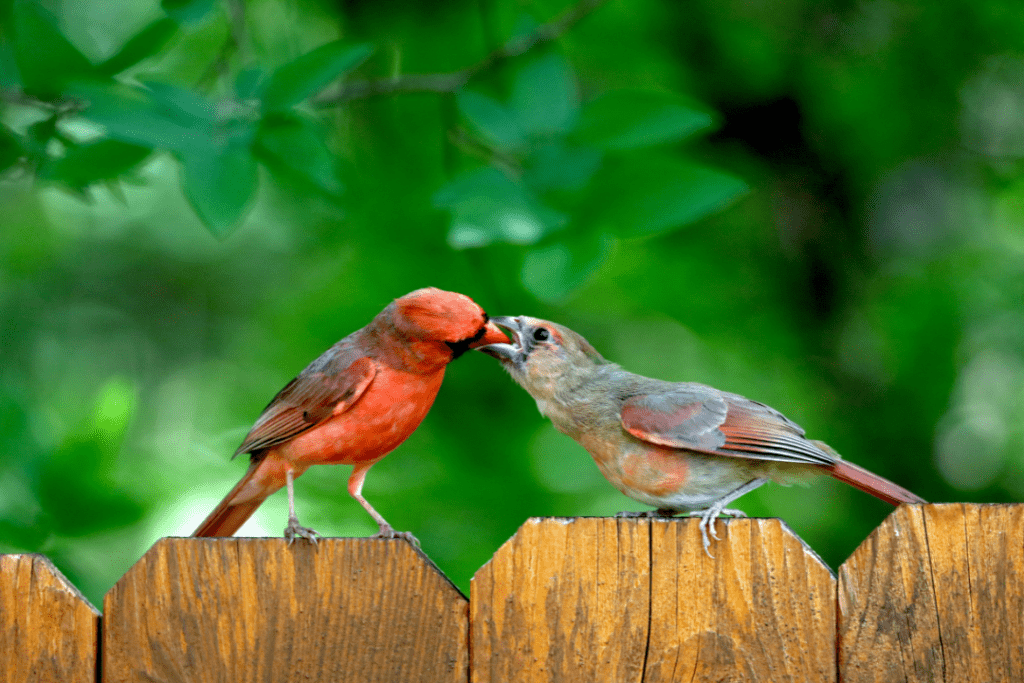The world of birds is full of fascinating secrets, and among them, the mating habits of cardinals stand out as a captivating topic. Many people wonder if these beautiful birds, known for their vibrant red color and melodic songs, mate for life. In this blog post, we’ll explore the cardinal’s mating behavior, the factors influencing their habits, and the impact of their monogamy on the cardinal population. So, let’s dive into the mesmerizing world of cardinal love.

Quick Answer: Do Cardinals Mate for Life?
Do cardinals mate for life? Cardinals primarily form monogamous, long-term pair bonds, but their relationships are not strictly lifelong. Their mating habits can be influenced by factors such as environmental conditions and competition, which can sometimes lead to variations like polygamy and mate switching.
Overview of Cardinals
Cardinals, or Cardinalidae, are a family of passerine birds found primarily in North and South America. The most well-known species is the Northern Cardinal, with its striking red plumage and distinctive crest, which is native to North America. Cardinals prefer woodland edges, gardens, shrublands, and swampy areas, often nesting in dense vegetation to protect their young.
These medium-sized birds display sexual dimorphism, with males sporting brilliant red feathers, while females are a more subdued brown with reddish accents. Both sexes have a distinctive crest, which they can raise or lower depending on their mood. Cardinals are known for their beautiful songs, often used in courtship displays and territory defense.
Mating Behavior of Cardinals
Cardinals exhibit a fascinating range of behaviors when it comes to finding a mate and establishing a bond. The courtship process begins with males singing to attract females. Males will often use their vibrant plumage and melodious songs to impress potential mates. When a female shows interest, the male will perform a “mate-feeding” ritual, offering her a seed or insect as a token of his ability to provide for her.
Once a pair is formed, they engage in a variety of bonding behaviors, such as preening each other and sharing food. The pair will also join together in song, creating a beautiful duet that strengthens their bond. During the nesting season, both the male and female work together to build a nest made of twigs, grasses, and other materials. The female will then lay a clutch of two to five eggs, which she incubates for 11 to 13 days while the male defends their territory and brings her food.
The Monogamy Question
The question of whether cardinals are monogamous and mate for life is a complex one. Cardinals are primarily monogamous, meaning that they form long-term pair bonds and remain with the same mate throughout the breeding season. In some cases, these bonds can last for several years. However, it is important to note that cardinals, like many other bird species, are not strictly monogamous in the sense that they never seek out new partners.
Research has shown that cardinals occasionally engage in what is known as “extra-pair copulations.” In these cases, a male or female cardinal may mate with an individual outside of their established pair bond. This behavior is relatively rare and typically occurs when a cardinal seeks to improve its chances of reproductive success by diversifying its genetic contribution to the next generation.
It is also worth noting that, while cardinals generally exhibit strong pair bonds, these bonds may be more fragile than they appear. If a cardinal’s mate dies or disappears, the surviving individual will often quickly seek out a new partner to ensure its continued reproductive success.
Factors Influencing Mating Habits
A variety of factors can influence the mating habits of cardinals. One of the primary drivers is environmental conditions, such as the availability of food and nesting sites. In years when resources are abundant, cardinals may be more likely to form long-term pair bonds, as the likelihood of successfully raising offspring is higher. Conversely, when resources are scarce, cardinals may be more likely to seek out additional mating opportunities to increase their chances of producing successful offspring.
Competition among cardinals can also play a role in shaping their mating habits. Males must compete for access to females and suitable territories, while females may be choosy about their mates, selecting those that demonstrate the best ability to provide for and protect their offspring. This competition can lead to complex mating dynamics, with some cardinals seeking out multiple partners to increase their chances of reproductive success.
Exceptions and Variations in Mating Behavior

While cardinals are primarily monogamous, there are instances where they deviate from this pattern. In some cases, a male cardinal may engage in polygamy, forming pair bonds with multiple females simultaneously. This behavior is relatively rare and typically occurs when a male is able to secure a particularly large and resource-rich territory, which can support multiple nests and families.
Another variation in cardinal mating behavior is the phenomenon of mate switching or replacement mates. If a cardinal loses its mate, either due to death or other circumstances, it will typically seek out a new partner relatively quickly to ensure its continued reproductive success. This demonstrates that while cardinals generally form strong pair bonds, these relationships are ultimately driven by the need to reproduce and pass on their genes.
What Happens When A Cardinal Loses their Mate?
When a cardinal loses its mate, the impact on the surviving individual can be quite significant. Cardinals, like many bird species, are known to exhibit signs of grief and distress when their partner is lost. This may manifest as changes in behavior, such as increased vocalizations or searching for the missing mate.
However, cardinals are ultimately driven by the need to reproduce and ensure the survival of their genes. As such, they will generally begin the process of finding a new mate relatively quickly after losing their previous partner. This may involve engaging in the same courtship behaviors used to attract their initial mate, such as singing and displaying their vibrant plumage.
Once a new partner has been secured, the cardinal pair will work together to build a nest and raise a new brood of offspring. In this way, the loss of a mate, while undoubtedly distressing, does not spell the end of a cardinal’s reproductive journey. Instead, it serves as a reminder of the resilience and adaptability of these beautiful birds.
The Impact of Mating Habits on Cardinal Population
The monogamous nature of cardinals and their long-term pair bonding play an essential role in maintaining stable population levels. By working together to raise their offspring, cardinal pairs can ensure that a higher percentage of their young survive to adulthood and reproduce themselves. This, in turn, contributes to a stable and healthy population.
Additionally, the occasional instances of polygamy, extra-pair copulations, and mate switching help to increase genetic diversity within the cardinal population. This diversity is crucial for the long-term survival of the species, as it enables cardinals to adapt to changing environmental conditions and resist diseases or other threats.
Conclusion
In conclusion, cardinals are fascinating creatures with intricate mating habits that captivate bird enthusiasts and casual observers alike. While they primarily form monogamous, long-term pair bonds, their behavior is more complex than simply “mating for life.” Their mating habits are influenced by environmental factors, competition, and the drive to reproduce, leading to variations such as polygamy and mate switching.
Ultimately, the mating habits of cardinals play a crucial role in maintaining their population, ensuring the continued survival and success of these vibrant and melodious birds.

James has always been an avid outdoorsman. Since a kid, he kept a journal of all the different birds and species he saw. Now he wants to share his passion with other birders with Happy Birding!
